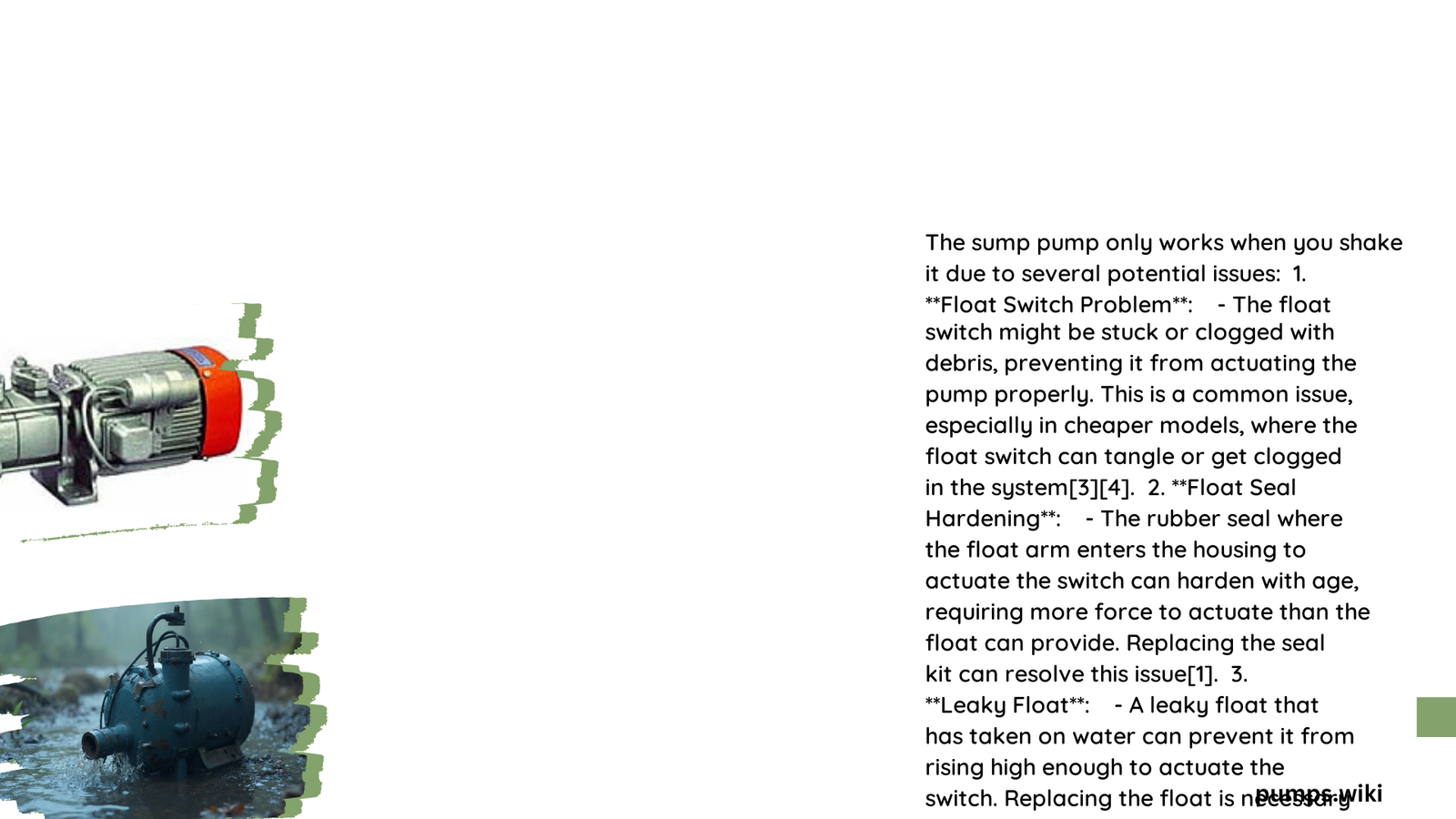A sump pump that only works when shaken is typically experiencing issues with its float switch or motor. This problem can lead to inadequate water removal and potential flooding. Common causes include a stuck float switch, debris interference, or motor malfunctions. Addressing this issue promptly is crucial to maintain proper pump function and prevent water damage.
Why Does My Sump Pump Only Work When Shaken?
The primary reason a sump pump only works when shaken is usually related to the float switch. When you shake the pump, you’re likely dislodging a stuck float or temporarily fixing an electrical connection issue. Here are the main causes:
- Stuck float switch
- Debris interference
- Faulty wiring
- Motor problems
Let’s dive deeper into each of these issues and how to address them.
What Are the Common Float Switch Problems?

Float switch problems are often the culprit when a sump pump only works after being shaken. Here are the most common issues:
- Stuck or jammed float: Debris, rust, or hardened seals can prevent the float from rising properly.
- Leaky float: A float that has taken on water won’t rise sufficiently to trigger the switch.
- Worn or hardened seals: Over time, rubber seals can harden, requiring more force to actuate the switch.
How Can I Test My Float Switch?
To test your float switch:
- Unplug the sump pump for safety.
- Manually lift the float to see if it moves freely.
- Listen for any internal movement in the float (indicating water infiltration).
- Check for visible debris or obstructions around the float.
If the float doesn’t move freely or you hear sloshing inside, it likely needs replacement.
How Do I Troubleshoot Motor Issues?
When the float switch isn’t the problem, the motor might be the culprit. Here’s how to troubleshoot:
- Check power supply: Ensure the pump is properly plugged in and the circuit breaker hasn’t tripped.
- Listen for unusual noises: Grinding or rattling sounds can indicate motor problems.
- Bypass the float switch: Try connecting the pump directly to power to test if the motor runs.
What Are the Signs of a Failing Sump Pump Motor?
Look out for these symptoms of a failing motor:
- Failure to turn on when the float switch is activated
- Continuous running even when water levels are low
- Unusual noises during operation
- Visible rust or damage to the motor housing
How Can I Maintain My Sump Pump to Prevent These Issues?
Regular maintenance is key to preventing sump pump problems. Here’s a maintenance schedule to follow:
| Task | Frequency |
|---|---|
| Clean sump pit and pump | Every 3-6 months |
| Check and clean float switch | Every 3-6 months |
| Lubricate moving parts | Annually |
| Replace float switch | Every 5-7 years |
| Replace seals | Every 5-7 years |
| Check motor condition | Annually |
What Are the Costs Associated with Sump Pump Repairs?
Here’s a breakdown of potential repair costs:
- Float switch replacement: $20-$50
- Seal kit replacement: $10-$30
- Motor replacement: $100-$300
- Wiring repairs: $50-$100
Remember, these are estimates and actual costs may vary depending on your location and the specific pump model.
When Should I Call a Professional?
While some sump pump issues can be DIY-fixed, certain situations warrant professional help:
- Electrical problems beyond simple wiring checks
- Persistent motor issues after basic troubleshooting
- Frequent pump failures despite regular maintenance
- Significant water damage or flooding
A professional plumber or pump technician can provide a thorough diagnosis and ensure proper repairs.
How Can I Prevent Future Sump Pump Issues?
To minimize the chances of your sump pump only working when shaken in the future:
- Perform regular maintenance as outlined above
- Keep the sump pit clean and free of debris
- Install a backup battery-powered pump for emergencies
- Consider a water alarm to alert you of high water levels
- Replace your sump pump every 7-10 years, even if it’s still functioning
By following these preventive measures, you can significantly reduce the likelihood of sump pump failures and the associated risks of water damage.
Remember, a properly functioning sump pump is crucial for protecting your home from water damage. If you’re experiencing persistent issues with your pump only working when shaken, don’t hesitate to address the problem promptly to ensure your home remains dry and safe.
References:
1. DoItYourself.com – Vertical float doesn’t turn on without manual lifting
2. Waterline Controls – Why Do Sump Pump Float Switches Fail?
3. Cranney Home Services – 10 Signs Your Sump Pump Needs Repair
